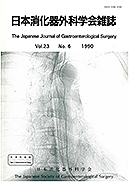All issues

Volume 52 (2019)
- Issue 12 Pages 695-
- Issue 11 Pages 611-
- Issue 10 Pages 551-
- Issue 9 Pages 485-
- Issue 8 Pages 405-
- Issue 7 Pages 345-
- Issue 6 Pages 281-
- Issue 5 Pages 239-
- Issue 4 Pages 191-
- Issue 3 Pages 137-
- Issue 2 Pages 83-
- Issue 1 Pages 1-
- Issue Special_Issue P・・・
- Issue Supplement2 Pag・・・
- Issue Supplement1 Pag・・・
Volume 23, Issue 6
Displaying 1-14 of 14 articles from this issue
- |<
- <
- 1
- >
- >|
-
Takeyuki Hiramatsu1990Volume 23Issue 6 Pages 1207-1219
Published: 1990
Released on J-STAGE: June 08, 2011
JOURNAL FREE ACCESSSkeletal muscle catabolism is of the characteristics of postoperative protein metabolism. Postoperative nutritional management, therefore, should be aimed at preventing muscle catabolism. Few data are available to show how muscle protein metabolism is affected by the route of nutritional substrate intake. This study investigated the effects of the route of nutrient intake on postoperative protein metabolism. Wistar rats that had received gastrectomy were infused with a total parenteral nutrition solution by either the enteral or parenteral route. On the 3rd or 7th postoperative day (POD), 15N-glycine was infused for 18-24 hours by either route. Whole-body protein turnover (WPT), synthesis, and breakdown were determined by urinary 15N total nitrogen enrichment. Fractional protein biosynthesis rates (FSR) for skeletal muscle and wounds were calculated by analyzing 15N tissue enrichment. IgA-containing cells and height of the intestinal villi were determined histochemically. Urinary catecholamine excretion was mesured by liquid chromatography. In parenterally fed rats, WPT and breakdown did not differ significantly between the 7th and 3rd POD. In contrast, WPT and breakdown in the enterally fed rats decreased from the 3rd to the 7th POD (p<0.02). Protein breakdown on 7th POD had a positive correlation with urinary catecholamine excreation. The enterally fed rats had a higher FSR for skeletal muscle on both the 3rd and the 7th POD than the parenterally fed rats. The wound FSR on 3rd POD was also higher in the enterally fed rats than the parenterally fed rats. Protein synthesis in the small intestine was also increased in the enterally fed rats, which was reflected in the greater villus height in the small intestine. We conclude that postoperative enteral nutrition augments intestinal protein synthesis and the defense mechanism and thus causes lower stress than parenteral nutrition. Lower stress and increased protein synthesis in the intestine may decrease whole-body protein breakdown and enhance muscle protein synthesis in postoperative enteral nutrition. Therefore, postopeartive early enteral nutrition is recommended for improving protein metabolism in muscle, wounds, and the wholebody.View full abstractDownload PDF (28447K) -
Koki Sunouchi1990Volume 23Issue 6 Pages 1220-1231
Published: 1990
Released on J-STAGE: June 08, 2011
JOURNAL FREE ACCESSThe role of prostablandin E2 (PGE2) both on hepatic metastasis of colorectal carcinoma and on the local immunity at the primary site was investigated. Forty six patients with colorectal carcinoma were divided into two groups; 14 with liver metastasis (group A) and 32 without liver metastasis (group B). Samples were obtained from the draining vein, from the afferent artery, and from the peripheral vein. The level of PGE2 was measured by RIA assay for each sample. The mean level of PGE2 from the draining vein was higher than those from both the feeding artery and the peripheral vein. These differences were statistically significant. The V/A ratio of PGE2 (PGE2 level of the draining vein/PGE2 level of the afferent artery) was also calculated. The V/A ratio of group A was significantly higher than that of group B. Histological (inflammatory cell infiltration), immunohistochemical (T cell subsets) and biochemical (inactivation of PGE2) examinations were performed to determine the local immunity in about half of the patients. In patients with liver metastasis, inflammatory cell infiltration, IL-2 receptor positive cells infiltration and the inactivation of PGE2 were decreased. We conclude that PGE2 could play a role in suppressing local immunity and have adverse effect on liver metastasis.View full abstractDownload PDF (25381K) -
1990Volume 23Issue 6 Pages 1292-1296
Published: June 01, 1990
Released on J-STAGE: February 17, 2011
JOURNAL FREE ACCESSDownload PDF (982K) -
1990Volume 23Issue 6 Pages 1299-1341
Published: June 01, 1990
Released on J-STAGE: February 17, 2011
JOURNAL FREE ACCESSDownload PDF (11047K) -
1990Volume 23Issue 6 Pages 1345-1389
Published: June 01, 1990
Released on J-STAGE: February 17, 2011
JOURNAL FREE ACCESSDownload PDF (13413K) -
1990Volume 23Issue 6 Pages 1395-1440
Published: June 01, 1990
Released on J-STAGE: February 17, 2011
JOURNAL FREE ACCESSDownload PDF (11022K) -
1990Volume 23Issue 6 Pages 1441-1480
Published: June 01, 1990
Released on J-STAGE: February 17, 2011
JOURNAL FREE ACCESSDownload PDF (9571K) -
1990Volume 23Issue 6 Pages 1481-1514
Published: June 01, 1990
Released on J-STAGE: February 17, 2011
JOURNAL FREE ACCESSDownload PDF (8419K) -
1990Volume 23Issue 6 Pages 1518-1560
Published: June 01, 1990
Released on J-STAGE: February 17, 2011
JOURNAL FREE ACCESSDownload PDF (10156K) -
1990Volume 23Issue 6 Pages 1561-1600
Published: June 01, 1990
Released on J-STAGE: February 17, 2011
JOURNAL FREE ACCESSDownload PDF (10052K) -
1990Volume 23Issue 6 Pages 1601-1640
Published: June 01, 1990
Released on J-STAGE: February 17, 2011
JOURNAL FREE ACCESSDownload PDF (9673K) -
1990Volume 23Issue 6 Pages 1641-1680
Published: June 01, 1990
Released on J-STAGE: February 17, 2011
JOURNAL FREE ACCESSDownload PDF (9905K) -
1990Volume 23Issue 6 Pages 1681-1730
Published: June 01, 1990
Released on J-STAGE: February 17, 2011
JOURNAL FREE ACCESSDownload PDF (12007K) -
1990Volume 23Issue 6 Pages 1731-1770
Published: June 01, 1990
Released on J-STAGE: February 17, 2011
JOURNAL FREE ACCESSDownload PDF (10221K)
- |<
- <
- 1
- >
- >|